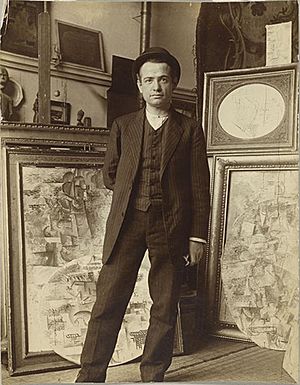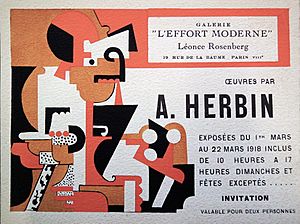Auguste Herbin facts for kids
Quick facts for kids
Auguste Herbin
|
|
|---|---|

Auguste Herbin in Pablo Picasso's studio, Boulevard de Clichy, early 1911
|
|
| Born | 4 Quiévy, Nord
|
| Died | 31 January 1960 (aged 77) |
| Nationality | French |
| Education | École des Beaux-Arts de Lille |
| Known for | Painting, printmaking, sculpture, drawing, collage |
| Movement | Post-Impressionism, Cubism, Abstract art |
Auguste Herbin (born April 29, 1882 – died January 31, 1960) was a French painter known for his unique modern art style. He is famous for his Cubist and abstract paintings. These artworks often feature bright, colorful geometric shapes. He also helped start important art groups like Abstraction-Création and Salon des Réalités Nouvelles. These groups worked to promote art that didn't show real-life objects.
Contents
Early Life and Art School
Auguste Herbin was born in a town called Quiévy, in the Nord region of France. His father was a skilled craftsman. From 1899 to 1901, Auguste studied drawing at the École des Beaux-Arts in Lille. After finishing his studies, he moved to Paris, a major art city.
Starting His Art Career
Auguste Herbin's early paintings showed influences from art styles like Impressionism and Post-impressionism. He displayed his work at big art shows, including the Salon des Indépendants in 1906. Soon after, he became interested in Fauvism, an art style known for its bold and bright colors. He showed his Fauvist works at the Salon d'Automne in 1907.
In 1909, Herbin moved to the Bateau-Lavoir studios in Paris. This was a famous place where many artists lived and worked. There, he met other important artists like Pablo Picasso, Georges Braque, and Juan Gris. These friendships encouraged him to start experimenting with Cubism. Cubism is an art style where objects are broken down into geometric shapes. In 1910, his work was shown alongside other famous Cubist painters at the Salon des Indépendants. In 1912, he took part in the important Section d'Or exhibition.
When World War I began in 1914, Herbin was too short for military service. Instead, he worked in an airplane factory near Paris.
Moving Towards Abstract Art
By 1917, Auguste Herbin began creating his first truly abstract paintings. These paintings didn't show any recognizable objects. His work caught the eye of Léonce Rosenberg, an art dealer. After World War I, Rosenberg included Herbin in a group of artists at his gallery, Galerie de l'Effort Moderne. Herbin's art was shown there in 1918 and 1921.
Herbin created unique artworks called "reliefs." These were simple geometric shapes made from painted wood. They were different from traditional paintings and challenged how people thought about art. However, these new works were not always understood by critics. Because of this, Herbin followed Rosenberg's advice and returned to a more realistic style of painting until about 1927. During this time, he painted landscapes and still lifes.
Herbin later didn't like these realistic paintings. He felt they were too simple. He also became less interested in the very strict, geometric forms used by the De Stijl art movement. After 1927, Herbin became fascinated by tiny pictures of crystals and plants. This led him to completely stop painting real-life objects and focus only on abstract art.
Later Years and New Art Groups
In the 1930s, Herbin helped start the Abstraction-Création group in Paris. He also worked as a writer and publisher for their art magazine, Abstraction-Création. Art non figurativ. In the magazine, he wrote about the importance of freedom and spoke out against unfairness. He was part of groups that wanted social change.
Starting in 1942, Herbin developed his own special system for art. He called it his "alphabet plastique" (plastic alphabet). In this system, his paintings were made only of colorful arrangements of triangles, circles, and rectangles. In 1946, he helped found the Salon des Réalités Nouvelles. This group was a follow-up to Abstraction-Création, and Herbin later became its vice-president.
Final Years
After 1953, Auguste Herbin became paralyzed on his right side. This meant he had to learn to paint with his left hand. He continued to create art until he passed away in Paris on January 31, 1960. One of his paintings was left unfinished. Its design was based on the word "Fin," which means "End" in French.
In the 2000s, a series of rugs based on Herbin's designs were made. These rugs were shown in France, Moscow, London, and New York. They helped people around the world rediscover Auguste Herbin's amazing art.
Public Collections
You can find Auguste Herbin's artworks in many public art collections, including:
- Museum de Fundatie, Zwolle, The Netherlands
- National Galleries of Scotland
- Matisse Museum, Le Cateau-Cambrésis, France
- Kunsten Museum of Modern Art Aalborg, Denmark
- Museum of Modern Art, Ceret, France
See also
 In Spanish: Auguste Herbin para niños
In Spanish: Auguste Herbin para niños



